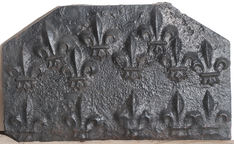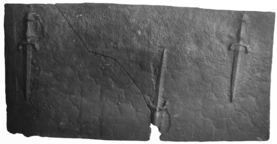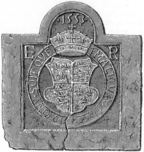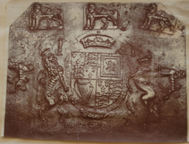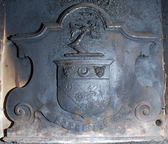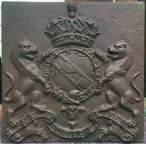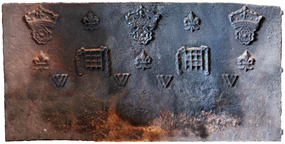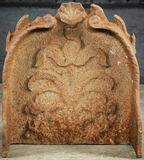-
439
Description: Fragment; left part only; this fireback comprises at least four separate elements: the rectangular central panel has an anchor with coiled rope between two fleurs de lys, below which are two roses; the rectangular side panels each comprise a vertical stem with six ‘grape bunches’ surmounted by a circular grape cluster; above, a semicircular arch contains the initials between two roses as in the central panel, with the date above; where the arch meets the central panel there is an arc across each corner. The side and top panels are edged with simulated twisted rope; to the left and botoom, a plain extension has been added before casting.
Notes: One of an unusual series formed from separate panels. The left panel is likely to have been repeated in the missing section. The extensions to the side and bottom will be unique to this casting which, because of the sharpness of the relief detail, is probably an early example. Because of its date and the use of the anchor motif, this much-copied plate is often referred to as the Armada fireback. No other connection with the sea battle is known. Other firebacks have been cast using some of the separate elements described.
Inscription: 1588 / IFC
- Decoration tags:
- rectangular with round arch (shape)
- none (edging)
- carved pattern panels
- heraldic
- text
- plants
- objects
Manufactured: in 1588 in the Weald area of England.
Current location: Anne of Cleves House, Southover High Street, Lewes, East Sussex, England.
Museum number: 1944.24.060 (part of the Sussex Archaeological Society museum group)
- Attached to series:
- Armada series
-
443
Description: Canted rectangle; plain plate with two rows of fleurs de lys, eight in the top row, three off set above the other five, and five in a single row along the bottom.
Notes: The fleurs-de-lys are the same as are seen on firebacks thought to have been cast at Pounsley.
- Decoration tags:
- rectangular with canted top corners (shape)
- none (edging)
- carved stamps
- heraldic
Manufactured: in the mid- to late-16th century possibly at Pounsley Furnace, Framfield in the Weald area of England.
Current location: Anne of Cleves House, Southover High Street, Lewes, East Sussex, England.
(part of the Sussex Archaeological Society museum group)
Citation: Butterfield, W. R., 1916, 'Old Wealden Firebacks', The Connoisseur, 46, pp. 197-209.
- Attached to series:
- Pounsley series
-
1047
Description: Sub-rectangular shape, no edging; three impressions formed of a dagger (c.350mm) with fleur-de-lys terminals: two, at each end, with the handle uppermost, the other inverted lower right of centre.
Notes: The dagger (length approx. 39cm) can be described as a 'cross-hilt' or 'quillon' type, possibly of German origin (ex. inf. Tobias Capwell). The grouping of three daggers may also have apotropaic significance in relation to the Trinity. Formerly part of the J. H. Every collection.
- Decoration tags:
- rectangular (shape)
- none (edging)
- simple stamps
- apotropaic
- objects
Manufactured: in the 16th century in the Weald area of England.
Current location: Anne of Cleves House, Southover High Street, Lewes, East Sussex, England.
Museum number: LH000.920 (part of the Sussex Archaeological Society museum group)
- Attached to series:
- Knife & Dagger stamp firebacks
-
467
Description: Arched rectangular with plain edges; arched rectangular inset with cavetto edging and armorial design in low relief: circular garter enclosing an ornate Tudor royal shield, surmounted by a crown; date inside top of arch; initials inside top corners of rectangle
Notes: Discovered by Mr Anthony Hill of the Plymouth ironworks, Glamorgan, in the 1820s, and believed by David Mushet, in his 'Papers on Iron and Steel' to have been cast at the early furnace on the opposite side of the River Taff; a variant of the same date (no. 288) has an inscription on the bottom panel and roses in relief at the bottom corners of the rectangle, which may have been obliterated by fire damage on this casting, the drawing showing it how the artist thought it might have looked originally. The west country source for both of these firebacks offers the possibility of an origin in those parts.
Inscription: HONV SOIT QVE MALE V [illegible]
Arms: Tudor royal - Edward VI
- Decoration tags:
- rectangular with round arch (shape)
- none (edging)
- whole carved pattern
- armorial
- royal
- text
Manufactured: in 1553 .
Current location: not known.
Citation: Mushet, D., 1840, Papers on Iron and Steel (London, John Weale), p. 393.
- Attached to series:
- Edwardian royal armorial firebacks
- Tudor royal armorial firebacks
-
1036
Description: Canted rectangular shape; no edging; lower centre, carved pattern panel of Stuart Royal arms: shield, garter, crown, motto, supporters and initials, RI separated by crown; lion statant guardant stamp repeated five times, three across top, one each side feet to left.
Notes: The impression of the decorative elements is irregular, with the achievement of arms under-pressed and the three lion stamps along the top over-pressed; the distinctive feature of the unicorn's horn in front of the initial R has been seen on a small number of other firebacks. From a photograph in the J. Starkie Gardner Collection, Victoria & Albert Museum, Archive of Art and Design (AAD/2014/8).
Inscription: I R
Arms: English Stuart royal - James I
- Decoration tags:
- rectangular with canted top corners (shape)
- none (edging)
- carved stamps
- carved pattern panels
- heraldic
- armorial
- royal
- text
- animals
Manufactured: in the early-17th century possibly in the Weald area of England.
Current location: Maidstone Museum, St Faith's Street, Maidstone, Kent, England.
(part of the Maidstone Museum museum group)
-
483
Description: Plain plate with scrolled side edges; canted arched rectangular astragal and fillet top moulding; central shield, crest and motto of the hardy family.
Inscription: ARMEE DE FOI HARDI
Arms: Hardy
- Decoration tags:
- rectangular with canted top corners and round arch (shape)
- none (edging)
- whole carved pattern
- armorial
- text
Manufactured: in the late-19th century at Low Moor Furnace in the Yorkshire area of England.
Current location: in private hands, Maresfield, East Sussex, England.
- Attached to series:
- Personal armorial firebacks
-
390
Description: Rectangular; plain plate with shield, supporters, ducal coronet, motto and garter of the Duke of Dorset: Quarterly, Or and gules, a bend vair.
Notes: Almost certainly the arms of Lionel Sackville KG (1688-1765), created first duke of Dorset in 1720. This particular design of fireback has been produced in a variety of sizes depending on the space around the achievement of arms
Copies of this fireback are known.
Inscription: HONI SOIT QUI MAL Y PENSE / AUT NUNQUAM TENTES, AUT PERFICE [Either do not attempt, or complete]
Arms: Lionel Sackville, 1st Duke of Dorset
- Decoration tags:
- rectangular (shape)
- none (edging)
- whole carved pattern
- armorial
- text
Manufactured: in the early-18th century in the Weald area of England.
Current location: in private hands Milford, Surrey, England.
Citation: Lloyd, N., 1925, 'Domestic Ironwork I', Architectural Review, 58, pp. 58-67.
- Attached to series:
- Dorset arms series
- Personal armorial firebacks
- Sackville firebacks
-
1222
Description: Rectangular shape; no edging; symmetrical arrangement of four stamps: across the top, three crowned roses with a fleur-de-lys between each pair; across the middle, three fleurs-de-lys with a chained portcullis between each pair; below and in the spaces between the fleurs and portcullises, four letters W.
Notes: The letter W may have an apotropaic significance; the stamps have not been recorded on other firebacks.
Inscription: W W W W
- Decoration tags:
- rectangular (shape)
- none (edging)
- carved stamps
- heraldic
- apotropaic
- text
- objects
Manufactured: in the late-16th century possibly in the Weald area of England.
Current location: Great Dixter, Northiam, East Sussex, England.
- Attached to series:
- Miscellaneous royal firebacks
-
1068
Description: Arched shape with forward-facing 'wings', which splay outwards towards the base, curved to follow the shape of the main panel; central panel with stylised tree decoration surmounted with a scallop shell between six 'leaves' (one damaged).
Notes: This small, but unusual, casting was probably cast in an open box mould as the upcast (reverse) side of the casting shows evidence of being sand-treated. Only a very small number of such castings are known. Depth 200mm.
- Decoration tags:
- free-standing (shape)
- none (edging)
- whole carved pattern
- plants
Manufactured: in the late-17th to early-18th century in England.
Current location: not known.
- Attached to series:
- Free-standing firebacks
-
506
Description: Plain rectangular shield with sloping edges; shield helm and crest of Sir Weetman Pearson Bt.: Per fess indented gules and or, between two suns in splendour in chief an escutcheon bearing a baronet's badge, and a demi-gryphon couped wings elevated and addorsed in base all counterchanged; crest: in front of a demi-gryphon as in the arms, holding between the claws a mill-stone proper, thereon a mill-rind sable, a sun in splendour.
Notes: Sir Weetman Pearson, later Viscount Cowdray, was created Baronet in 1894 and Baron in 1910, the fireback thus dates from the period 1894-1910. The motto - Do it with thy might - is from Ecclesiates 9: 10.
Copies of this fireback are known.
Inscription: DO IT WITH THY MIGHT
Arms: Sir Weetman Pearson Bt
- Decoration tags:
- complex individual (shape)
- none (edging)
- whole carved pattern
- armorial
- text
Manufactured: in the late-19th century in England.
Current location: Parham House, Parham, West Sussex, England.
- Attached to series:
- Personal armorial firebacks

